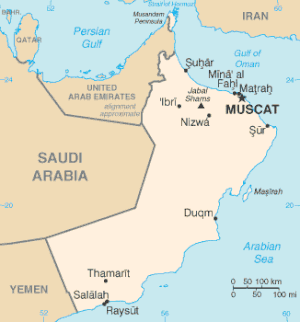Hospitals in Muscat Governorate
The following hospitals are located in the Muscat Governorate. The locations within the Governorate are indicated when known:

| Name | Location within Muscat | Opened/Refs |
|---|---|---|
| Abeer Hospital | Ruwi | [3] [4] |
| Al Hayat International Hospital (Cardiology, Orthopaedics, Diabetes, Gyneac and other specialities) and Al Hayat polyclinics (Al Ghubra, Sohar and Al Hail) | Al-Ghubra | [5] |
| Al Khair Hospital | Ibri | [6] |
| Al Masarra Hospital (Psychiatric Hospital) | Al Hesheia Area at Al-Amerat Willayat | 2013 [1] |
| Al Nahdha Hospital | Ruwi | 1972 [1] [7] |
| Al Shalti Hospital | [7] | |
| Aster Al Raffah Hospital | Al-Ghubra Roundabout | [8] [9] [7] |
| Apollo Hospital | Hamriyah | [10] |
| Armed Forces Hospital | Al-Koudh | [11] |
| Badr al Samaa Group of hospitals and polyclinics | Ruwi, Al Khoud, and Al Khuwair | (Ruwi) [12] [4] (Al Khoud) [12] [4] (Al Khuwair) [4] |
| Bilad Bahi Bu Ali Hospital | [7] | |
| Boukha Hospital | [7] | |
| Burjeel Hospital | Al Khuwair | [13] |
| Deba Hospital | [7] | |
| Fakih IVF Hospital | [7] | |
| Gulf Specialized Hospital | Al Wattaya (Maktabi Building) | [14] |
| Haima Hospital | [7] | |
| Hamdan Hospital | [7] | |
| Ibn Sina Hospital | 1984 [7] | |
| Ibri Hospital | Ibri | [7] |
| Izki Hospital | [7] | |
| Khoula Hospital (National Trauma Center) | Al Wattya | 1974 [7] [4] [15] |
| KIMS Oman Hospital | Darsait | [16] [17] |
| Lifeline Hospital | Salalah | |
| Lifeline Hospital | Sohar | [4] |
| Masirah Hospital | [7] | |
| Muscat Private Hospital | [18] [7] | |
| Muscat Private Hospital and IVF Center | [12] [19] | |
| NMC Healthcare Specialty Hospital | Al-Ghoubra | [20] [4] |
| NMC Healthcare Specialty Hospital | Ruwi | |
| NMC Healthcare Specialty Hospital | Al Hail | [20] |
| Oman International Hospital | Ghubrah and Muscat | [21] |
| Police Hospital | [7] | |
| Quiriyat Hospital | Qurayyat | |
| The Royal Hospital | Bosher | 1987 [1] [15] |
| Starcare Group of Hospitals (Seeb) | Seeb | [12] [4] [22] |
| Starcare Group of Hospitals (Bousher) | Bousher | [22] |
| Sultan Qaboos University Hospital | Seeb | 1990 [15] |
| Wadi Mistal Hospital | Nakhal |

